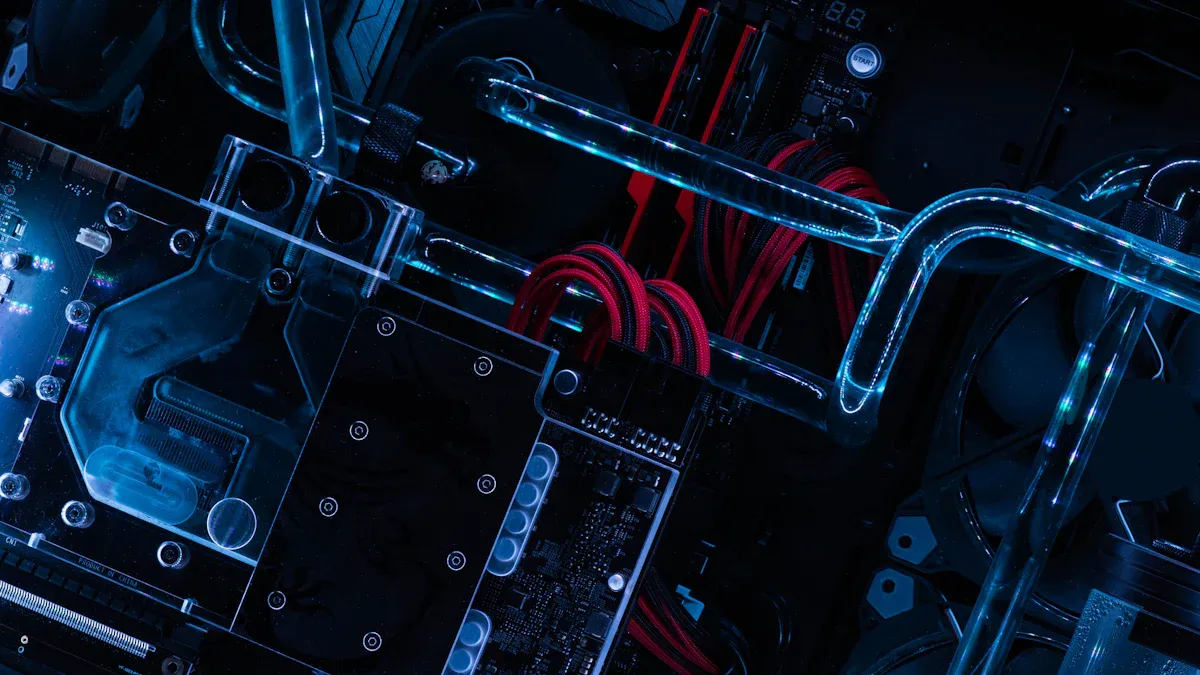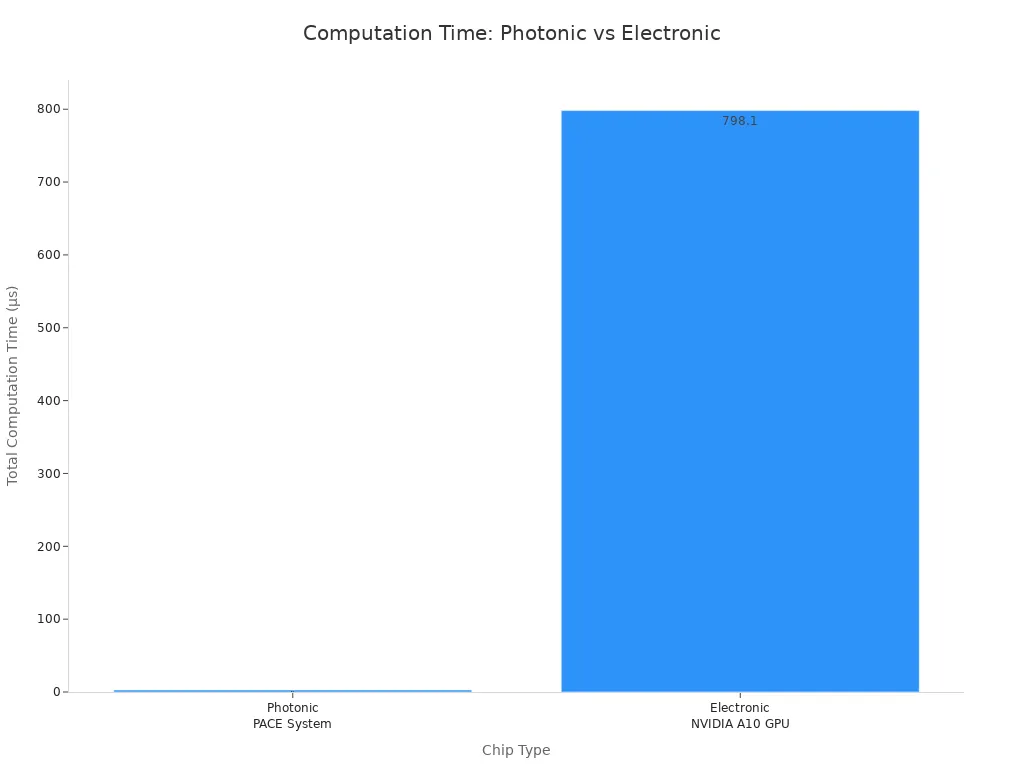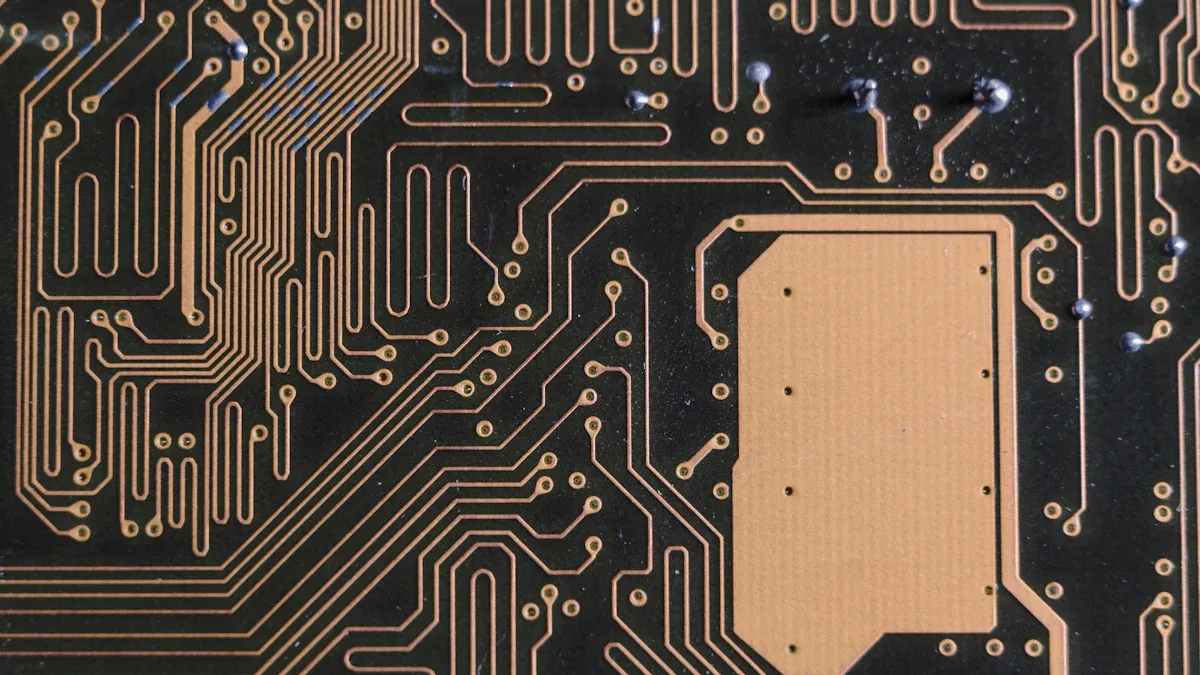What Is a Photonic Chip and How Does It Work

A photonic chip is a tiny microchip that uses light, or photons, to process and send information. Unlike regular chips that move electrons, this chip guides photons through parts like waveguides and lasers to get work done. This approach brings major benefits in speed and energy use. For example, some photonic chips can solve problems up to 500 times faster than top electronic chips.
Think of a photonic chip like a super-fast highway for light, where data travels at incredible speeds with less traffic and fewer stops.
Chip Model | Speed Improvement | Energy Efficiency |
|---|---|---|
Lightelligence PACE | 500× faster than leading GPU systems | - |
ACCEL chip | 1000× better energy efficiency |
Key Takeaways
Photonic chips use light instead of electricity to process data, making them much faster and more energy efficient than regular chips.
These chips guide light through tiny paths and use special parts like lasers and waveguides to control and send information quickly.
Photonic chips generate less heat and avoid electrical interference, which helps devices run cooler and more reliably.
They are ideal for powerful tasks like artificial intelligence, data centers, healthcare devices, and autonomous vehicles.
Despite their benefits, photonic chips face challenges in manufacturing and cost, but ongoing research aims to overcome these hurdles.
Photonic Chip Basics

What Is a Photonic Chip
A photonic chip is a small device that uses light to move and process information. Instead of sending electrical signals, it guides photons through tiny paths called waveguides. These chips use special materials like silicon, indium phosphide, and silicon nitride. Each material helps control light in different ways. For example, silicon works well with existing chip factories, while indium phosphide is good for making light sources and detectors. Thin film lithium niobate and barium titanite help with fast switching and signal changes.
Modern photonic chips can fit many parts into a tiny space. Engineers use special designs, such as subwavelength grating waveguides, to keep light signals from interfering with each other. This allows the chip to pack more waveguides close together. Some chips use 3D bonding to connect thousands of tiny parts, making them even more powerful and compact.
Photonic chips use the wave-particle duality of light, which means light acts both like a wave and a particle. This property lets the chip control photons for fast and efficient data processing.
Key Features
Photonic chips stand out because of several important features:
They use light signals instead of electrical signals, which allows data to travel faster and farther with less loss.
These chips can combine photonic and electronic parts on a single chip, making devices smarter and more energy efficient.
Photonic chips often run hundreds of times faster than regular electronic chips and keep signals strong over long distances.
They open the door to new uses, such as quantum computing, artificial intelligence, and advanced sensors.
The combination of photonics and electronics creates compact and cost-effective devices.
A photonic chip also generates less heat and uses less power than traditional chips. Light signals do not face resistance like electrical signals, so they waste less energy as heat. This makes photonic chips ideal for places where cooling is hard or where energy savings matter, such as data centers and AI accelerators.
Feature | Photonic Chip | Electronic Chip |
|---|---|---|
Signal Type | Light (photons) | Electricity (electrons) |
Speed | Very high | High |
Energy Efficiency | Excellent | Moderate |
Heat Generation | Low | High |
Electromagnetic Interference | None | Possible |
Why Use Light
Light offers many advantages for information processing. Photonic chips can send data at speeds much higher than electronic chips. Light signals can carry more information at once because they can use different colors (wavelengths) at the same time. This increases the amount of data the chip can handle.
Light travels through waveguides with almost no energy loss, so photonic chips use less power and stay cooler.
Photonic chips do not suffer from electromagnetic interference, which makes them more reliable.
They work well for tasks that need fast and large-scale data handling, such as AI and machine learning.
Scientists have shown that photonic chips can run machine-learning tasks with high accuracy and low energy use. For example, a chip using special LEDs analyzed patient movement data and reached 92% accuracy. Controlling LEDs also uses less energy than lasers, making the system even more efficient.
Using light in a photonic chip means faster speeds, lower energy use, and new possibilities for technology.
How Photonic Chips Work
Main Components
A photonic chip uses several key parts to control and move light. Each part has a special job. The table below shows the main components and what they do:
Component | Function |
|---|---|
Laser | Generates coherent light as a source within the photonic chip. |
Waveguide | Acts as a low-loss interconnect carrying optical signals between components. |
Phase Modulator/Shifter | Modulates or shifts the phase of light by changing refractive index via electrical signals. |
Coupler and Splitter | Combines multiple input signals into one output or splits multiplexed signals into separate waveguides. |
Filter | Selectively blocks or passes specific wavelengths using interferometer structures. |
Optical Amplifier | Amplifies optical signals without altering them to maintain signal strength. |
Photodetector | Converts optical signals into electrical signals for measurement and processing. |
These components work together to guide, change, and detect light signals inside the chip.
Processing with Light
A photonic chip processes information using photons instead of electrons. The steps below show how it handles data:
The chip encodes information, like neural network parameters, into light signals.
Arrays of programmable beamsplitters perform matrix multiplication with these light signals.
Some light diverts to photodiodes, which turn optical signals into electrical current for nonlinear functions.
Most processing stays in the optical domain, which keeps latency very low.
Electronic circuits help with calibration, control, and reading out the final result.
This method allows the chip to solve complex problems much faster than traditional chips. For example, a photonic chip called PACE solved a hard math problem in about 2.7 microseconds, while a top electronic chip took almost 800 microseconds. The chart below shows this big difference in speed:

Photonic chips can process data over 100 times faster than some electronic chips, thanks to their unique way of using light.
Signal Transmission
Photonic chips send signals using light instead of electricity. Lasers create the light, and modulators turn electrical signals into optical ones. Waveguides act like tiny roads, guiding the light through the chip. Photodetectors change the light back into electrical signals when needed. Some chips use wavelength division multiplexing, which lets them send many data streams at once by using different colors of light. In labs, these chips can reach data rates over 100 gigabits per second. In commercial networks, speeds often reach 1 gigabit per second. New research aims to make these rates even higher.
Photonic Chip vs. Electronic Chip

Differences
A photonic chip and an electronic chip work in very different ways. The photonic chip uses light, or photons, to move and process information. It relies on optical components like waveguides, modulators, and transceivers built into semiconductor materials. These chips can perform computations, including nonlinear functions, by controlling light in special materials such as InGaAsP. This allows for reconfigurable and programmable optical processing. In contrast, electronic chips use the flow of electrons through circuits and transistors to handle data. Electronic chips depend on electrical signals and traditional transistor-based designs. Photonic chips often use silicon photonics technology, which brings new devices and architectures. However, combining photonic and electronic circuits on one chip remains a complex task due to differences in processing and packaging.
Advantages
Photonic chips offer several important benefits over electronic chips:
They use photons instead of electrons, which allows for higher speeds and greater bandwidth.
These chips avoid electrical resistance and heat loss, leading to better energy efficiency.
Photonic computing works well for matrix multiplications, which are key in artificial intelligence.
Photonic integrated circuits (PICs) make it possible to shrink complex optical systems onto small chips, supporting high-volume manufacturing and lower costs.
Recent advances, such as chip-scale optical isolators, have improved efficiency and versatility.
PICs support a wide range of uses, including data communications, LiDAR, quantum computing, and healthcare diagnostics.
The table below shows some performance numbers:
Study (Author, Year) | Photonic Chip Performance Metric | Quantitative Value |
|---|---|---|
Weigel et al. (2018) | Modulation bandwidth | |
Bai et al. (2021) | Real-time data rate | 18.8 Gbps |
Photonic chips can reach speeds and data rates that electronic chips cannot match, making them ideal for next-generation computing.
Challenges
Despite their promise, photonic chips face several challenges:
Precise chip-to-wafer bonding is difficult, as even tiny defects can cause optical losses.
Efficient light coupling between fibers and waveguides remains a technical hurdle.
Environmental factors like moisture and dust can damage optical interfaces, so new protective methods are needed.
Energy efficiency must improve to meet the demands of AI and data centers.
Manufacturing and packaging require high precision, and current manual processes are not scalable.
The ecosystem for design tools and standardized packaging is still developing.
Materials like thin-film lithium niobate are fragile, making large-scale production hard.
Advanced equipment and expertise are needed, which increases costs and slows mass adoption.
The path to widespread use of photonic chips includes solving technical, manufacturing, and cost challenges.
Applications
Data Centers
Data centers need to move huge amounts of data quickly and efficiently. Companies use advanced optical technology to boost speed and save energy. For example, new networking systems can reach up to 1.6 terabits per second per port and cut power use by more than half. Major tech firms work together to create chips that improve performance and lower costs. Governments also invest millions of dollars to support new production centers. The market for these chips is growing fast, with North America leading and Asia Pacific expanding quickly. The table below shows some key facts:
Aspect | Details |
|---|---|
Market Size (2024) | |
Projected Size (2034) | USD 97.62 billion |
Fastest Growing Region | Asia Pacific |
Key Advantages | High speed, energy savings, less heat |
Industry Developments | New partnerships, government funding, startup growth |
Optical circuit switching and silicon photonics help data centers handle more data with less energy. These advances make cloud computing, AI, and 5G networks faster and more reliable.
AI and Computing
AI and high-performance computing need fast and efficient chips. Light-based analog computation allows these systems to process information with high precision and low energy use. Hybrid designs combine optics and electronics, making it easier to use these chips with current AI tools. New chips can perform both linear and nonlinear operations using light, which speeds up AI training and reduces power needs. Some chips complete complex tasks in less than half a nanosecond and match or beat the accuracy of top electronic hardware. These breakthroughs help AI data centers manage large workloads and support real-time learning.
Healthcare
Healthcare uses optical chips in many ways. Biosensors with high sensitivity and real-time operation help doctors diagnose diseases quickly and accurately. These sensors can fit into small, portable devices for use at the point of care. Wearable devices, like smartwatches, use these chips to monitor blood flow and other health signs without needles. Home testing platforms let people check their health easily and get lab-quality results. Surgeons use optical sensors for real-time feedback during operations, improving safety and precision. The table below highlights some uses:
Application Area | Description | Example/Company |
|---|---|---|
Small devices for eye and tumor checks | Handheld OCT probes | |
Point-of-Care Biosensors | Fast, accurate disease detection | PHIX biosensing platform |
Home Blood Testing | Quick, multi-marker tests at home | SiPhox Health |
Wearables | Continuous health monitoring | Smartwatch sensors |
Surgery Sensors | Real-time feedback for surgeons | ASPICs |
Autonomous Vehicles
Autonomous vehicles rely on advanced sensors to see and understand their surroundings. Integrated optical circuits make lidar and other sensors smaller, lighter, and more accurate. These chips allow for solid-state scanning, which means no moving parts and better reliability. New packaging methods let engineers combine optical and electronic parts on one chip, making sensors compact and easy to produce. These sensors can scan the environment quickly, helping cars detect objects and navigate safely. Optical gyroscopes built into these chips provide precise navigation, even when GPS signals are weak. Recent advances allow image processing to happen directly on the sensor chip, speeding up decision-making for safer driving.
Photonics technology continues to shape the future of computing, healthcare, and communications. The global photonics market is expected to grow at a 6.7% annual rate through 2032, driven by new devices in many industries. Experts predict that advances in silicon photonics, quantum computing, and biophotonics will transform daily life and industry. Recent breakthroughs include energy-efficient lasers, scalable quantum platforms, and smarter AI hardware.
Breakthrough Aspect | Description |
|---|---|
Laser Innovation | Efficient silicon-based lasers for on-chip integration |
Quantum Platform | Manufacturable silicon photonics for quantum computing |
AI Hardware | Photonic quantum chips boost machine learning and save energy |
Staying informed about photonics will help readers understand the next wave of technology.
FAQ
What makes a photonic chip different from a regular chip?
A photonic chip uses light to move and process information. An electronic chip uses electricity. Light travels faster than electricity, so photonic chips can work at higher speeds and use less energy.
Can photonic chips replace all electronic chips?
Photonic chips work well for some tasks, like fast data transfer and AI. They do not replace all electronic chips yet. Many devices still need electronic parts for control and storage.
Are photonic chips safe to use?
Yes, photonic chips are safe. They use light inside the chip, so people do not get exposed. The materials and designs follow safety standards for electronics.
How small are photonic chips?
Most photonic chips are about the size of a fingernail. Engineers can fit many tiny parts on one chip. This small size helps save space in computers and other devices.
Where can people find photonic chips today?
People can find photonic chips in data centers, high-speed internet equipment, and some medical devices. Companies also use them in research labs and new AI hardware.
See Also
Understanding Optocoupler IC Chips And Their Functionality
Exploring Computer Chips And How They Operate Effectively
A Detailed Look At Communication Chips And Their Operation
